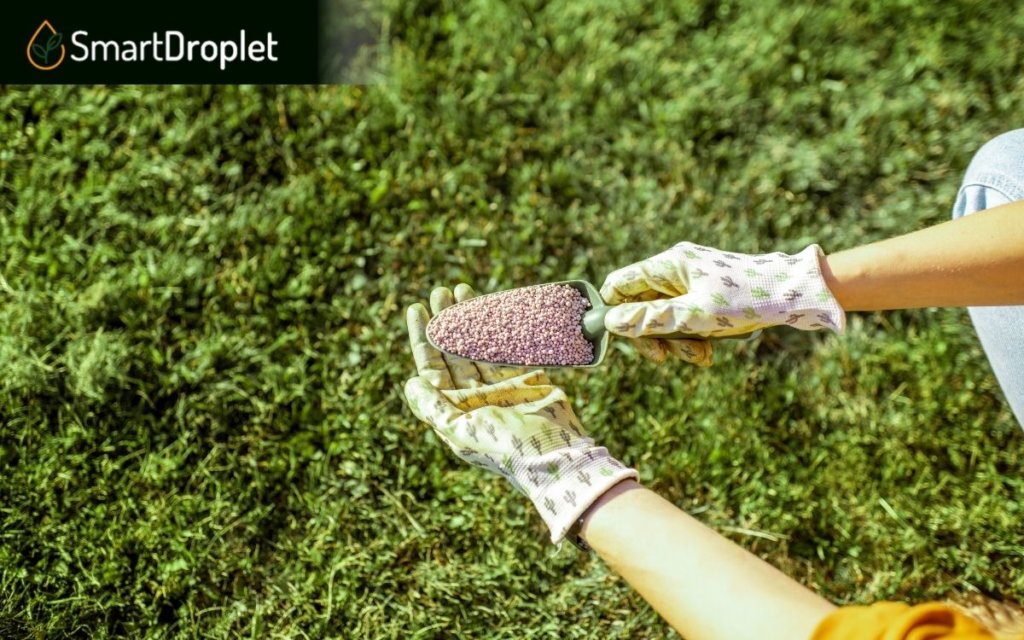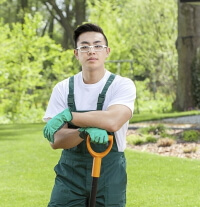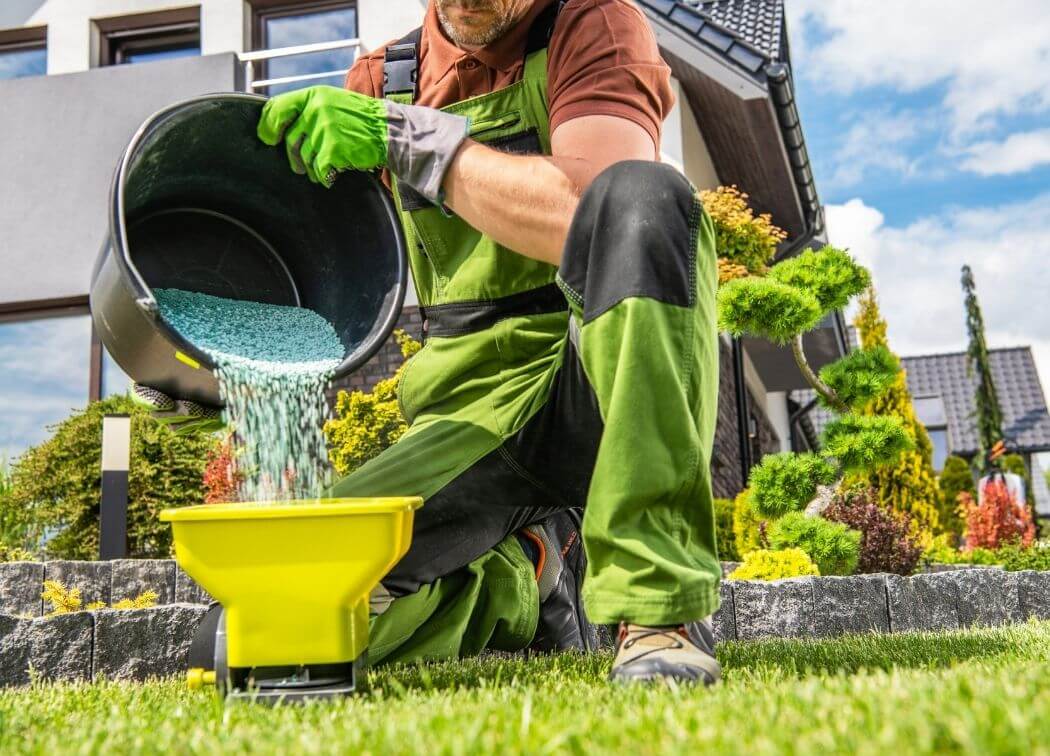A healthy St. Augustine lawn requires more than primary care. Fertilizers are crucial to maintaining disease-free and deep green lawn grass.
More than the beautiful appearance, synthetic and organic fertilizer types will save you time killing pests and weeds! Here are our best picks.

Lesco Professional St. Augustine Weed Fertilizer
- 16-4-8 N-P-K high nitrogen great for St. Augustine lawns
- 2-in-1 formula feeds your St. Augustine adequately.
- Other N-P-K ratios are available.

Simple Lawn Solutions Extreme Grass Growth Lawn Booster
- 16-4-8 N-P-K greens quickly in about 7 days.
- 100% natural liquid fertilizer.
- Has humic acid for lawn soil health.

Milorganite 0636 Organic Nitrogen Fetilizer
- Faster greening of St. Augustine lawns.
- High nitrogen content for faster growth.
- Highly-rated organic fertilizer for lawns.
The Best Fertilizers for St. Augustine Grass
After much fertilizer analysis, trials, and research, we’ve come up with this list.
The primary considerations were based on the right amount of nitrogen, effectivity, whether it burns the grass, and ingredients.
1.) Lesco Professional St. Augustine Weed & Feed Fertilizer 17-0-7
With the numerous fertilizers out there, the selection can get confusing. Lesco Professional Weed & Feed is a specific fertilizer for St. Augustine grass, which lessens your burden knowing it already contains the appropriate contents needed.

Product Features
Here are the features that stood out:
- Type: Slow-release fertilizer (up to 8 weeks of feeding); turf fertilizer; weed and feed
- Product Dimensions: 4 x 12 x 24 inches; 50 lbs
- Main Ingredient: 30% poly-coated sulfur coated urea
- NPK Ratio: 17-0-7
- Area Capacity: up to 13,000 square feet
The fact that it’s a weed and feed fertilizer is already a plus point.
It’s not only fertilizer with the essential nutrients, but it also contains herbicides and chemicals suitable for killing off grassy weeds upon application.
With suitable fertilizer applications, you’ll see beautiful and green St. Augustine grass in no time.
The recommended application period is during early spring, simultaneously meeting the growing season and killing the weeds.
Benefits Worth Mentioning
- Easy to use; beginner-friendly
- Meets the required nitrogen fertilizer level
- It also contains iron that helps with brown patches
- Specific to St. Augustine grass lawn
Drawbacks to Consider
- Not exactly rain-proof
- Unsafe for pets (but so is any other non-organic fertilizer)
2.) Simple Lawn Solutions Extreme Grass Growth Lawn Booster
It’s already in the name. The Simple Lawn Solutions Booster is known for its fast growth and high effectiveness.

Product Features
- Type: Concentrated liquid fertilizer; Phosphorus and nitrogen fertilizer
- Product Dimensions: 5.5 x 3 x 9 inches; 2.99 lbs
- Main Ingredient(s): 18% phosphate concentrate; humic acid formula; 6% nitrogen
- NPK Ratio: 6-18-19
- Area Capacity: Treats up to 3,200 square feet
The better term to describe this from Simple Lawn is a nutritional product. It’s not for disease control or weed killing but as a liquid fertilizer treatment.
It’s a solution for improving nutrient deficiency, helping root growth, or starting up a lawn.
If these matches your needs, you’ll find this product highly effective. But all else, you may want to consider other types.
Benefits Worth Mentioning
- Helps with vertical and lateral growth; excellent for new St. Augustine sod
- Easy application and set-up
- Usable for different grass types, not just St. Augustine turf
- Great for starting lawns to ensure healthy plant growth
Drawbacks to Consider
- Area coverage is not as vast as other fertilizers.
- The hose sprayer applicator can be further improved.
3.) Milorganite 0636 Organic Nitrogen Fetilizer
Organic fertilizers are friendlier to a St. Augustine lawn and in general. The ingredients are more pet and child-friendly but still work well.

Product Features
- Type: Slow-release nitrogen fertilizer
- Product Dimensions: 4 x 16 x 22 inches; 32 lbs
- Main Ingredient(s): 4% non-staining iron
- Area Capacity: Treats up to 2,500 square feet
It’s easily the best fertilizer that makes you stop worrying about harsh chemicals. It doesn’t burn but instead helps you maintain a greener lawn.
There are some complaints that it’s pricier than other fertilizers, although it worked the best. We suggest checking local stores or other sources first!
Benefits Worth Mentioning
- Eco-friendly
- Does not damage or burn the lawn
- Reduces the need for watering and mowing
- Highly effective and can compete with non-organic lawn fertilizers.
Drawbacks to Consider
- Some sellers tend to sell overpriced fertilizer bags of this product (check your local stores first).
4.) Scotts Turf Builder Lawn Food
There’s no question when we say Scotts. It’s a well-trusted brand for many lawn caretakers, so you already know its quality.

Product Features
- Type: Turf fertilizer
- Product Dimensions: 20.1 x 4.1 x 13.1 inches; 28.3 lbs
- Main Ingredient(s): 2% iron, high nitrogen fertilizer
- NPK Ratio: 32-0-4
- Area Capacity: Treats up to 10,000 square feet
While it’s undeniably a good fertilizer for St. Augustine grass, always apply with ample amounts only.
Too much nitrogen also burns lawn weeds alright, but it can also burn the healthy grass if not used well.
Overall, we think the product itself is excellent. It’s just too intense for some.
Benefits Worth Mentioning
- Great for deep greening
- Usable for any season
- Specifically protects against heat and drought
- It helps with the lawn’s ability to absorb water and nutrients
- Cover an expansive lawn area; great for commercial use
- It also kills weeds
Drawbacks to Consider
- High chemical levels may burn your lawn; avoid using excess fertilizer.
5.) Pennington’s Weed & Feed
We have another weed and feed on the list! This one from Pennington kills up to 250 types of broadleaf and grassy weeds like chickweed, dandelion, white clover, etc.

Product Features
- Type: Weed and feed lawn fertilizer; slow-release fertilizer and quick-acting nitrogen combined; granular fertilizer
- Product Dimensions: 4 x 11 x 16.75 inches; 13.15 lbs
- Main Ingredient(s): iron, 10.56% slow-release nitrogen
- NPK Ratio: 30-0-4
- Area Capacity: Treats up to 5,000 square feet
Pennington’s weed and feed fertilizer is a favorite in the fertilizer category. Users vouch for its effectiveness in terms of thickening St. Augustine grass lawns.
But make sure that you follow the instructions well when applying fertilizer and don’t expect it to work in ways other than the brand’s claims.
Benefits Worth Mentioning
- Best fertilizer that can kill 250 types of weeds
- Suitable for both northern and southern lawns
- Has an extended feeding for up to 3 months
Drawbacks to Consider
- Not suitable for floral St. Augustine lawns
- Moisture conditions will affect greening results
6.) Dr. Earth Organic Super Natural Lawn Fertilizer
Another one for the team organic is this one from Dr. Earth. It’s an all-purpose fertilizer safe for different kinds of plants and lawns.

Product Features
- Type: Organic fertilizer; slow-release fertilizers
- Product Dimensions: 2 x 13 x 2o inches; 11.92 lbs
- Main Ingredient(s): Non-GMO; rich in humic acid; 100% organic and natural
- Area Capacity: Treats up to 360 square feet
- NPK: 9-0-5
If your goal is to have your St. Augustine grass lawn and other flowering plants bloom like crazy, you’ve found one of the best lawn fertilizers right here!
Any review you look up online will tell you that the Spring green-up growth was terrific after using this one from Dr. Earth. Plus, it doesn’t burn your lawn.
Benefits Worth Mentioning
- Low chemical content; won’t burn your lawns
- Safe for kids and pets
- Can feed lawn over a long period, thanks to its slow-release aspect
Drawbacks to Consider
- Area coverage is smaller than other products.
7.) Scotts EZ Patch Lawn Repair Fertilizer
If you’re looking for a lawn repair fertilizer, Scotts is here to the rescue once again. It’s for the dense-growth-but-some-spots-could-use-some-improvement type of lawns.

Product Features
- Type: Repair fertilizer; ready-to-use mulch
- Product Dimensions: 4.75 x 12.25 x 8.64 inches; 4.29 lbs
- Main Ingredient(s): Combination mulch and fertilizer repairs
- Area Capacity: Treats up to 85 square feet
While it may not be as fast-acting as advertised, it’s still a good repair fertilizer for St. Augustine grass. It’s best for bare spots and patches, not the entire lawn.
Make sure to follow correct instructions and ensure that a repair solution is what your lawn conditions genuinely need for it to work best.
Benefits Worth Mentioning
- St. Augustine grass thrives and repairs 60% better after application.
- It’s precisely to fertilize St. Augustine grass.
- The mulch absorbs 6x its weight in water
- Works excellent with plugs and sods
Drawbacks to Consider
- It does not contain grass seed.
- Spots of the lawn directly treated may show a blue-green color or stain.
Best Nitrogen Fertilizers for St Augustine Grass
We’ve briefly mentioned the criteria we used to find the best St. Augustine grass fertilizers.
This section will help you understand these better as we explain what you need to look for in St. Augustine grass fertilizers.
- It should be fast-feeding.
- It should be rich in nitrogen.
- It helps if it also has high iron content for greening.
- It should be a slow-release or a combination of slow and quick action (to be discussed in the next section).
That said, the best overall nitrogen fertilizer meeting most criteria is the Milogranite 0636 Organic Nitrogen Fertilizer. It has the right amount of nitrogen and helps with extended feeding the entire growing season.
On top of that, it’s organic! It’s a win-win situation if you ask me. We particularly appreciate that it doesn’t contain burning chemicals but still lives up to the performance of other fertilizers.
Pro Tip: Avoid using fertilizers with high amounts of phosphorus because they cause deficiencies of zin and iron to your lawn. Ensure you do a soil test to properly manage what nutrients are required for your lawn before starting your spring St. Augustine fertilizer calendar.
Slow-Release vs. Quick Release Fertilizers
We have mentioned the terms slow-release and quick-release multiple times above. Let’s understand what they mean.
Slow-Release
Slow-release fertilizers are insoluble. As the name goes, they are slower to produce results (approximately up to 10-11 weeks).
Despite the slower results, it’s also the preferred type because it doesn’t burn the lawn even during the peak of summer, and it’s lower maintenance since repetitive application is not required.
Although a little expensive, the effectiveness makes it a worthy investment.
Quick-Release
On the other hand, quick-release fertilizer types are soluble. The results are much faster, and you’ll see results as early as two weeks. That’s a lot quicker in comparison.
However, fast-action also brings drawbacks such as more potent chemicals. Prepare for some burning, especially at higher temperatures.

Fertilizer for Floratam St. Augustine Grass
Floratam is a hybrid type of St. Augustine grass. To briefly explain its origin, it was developed by the University of Florida and Texas A&M University in 1973. Hence, the name FloraTAM.
The variant is known for its fast growth and resistance to pests. As warm-season grass, it can’t survive freezing situations and needs plenty of sunshine in a day.
Because Floratam St. Augustine grass grows fast (we’re talking about up to 3/4 lateral growth in just a day), it’s heavy on feeding.
The fertilizer you need must fulfill its needed nutrients, and they need fertilizer six times a year. Here are some other tips for your Floratam St. Augustine grass:
- Apply a 19-5-8 fertilizer (or anything similar) to new seeds.
- Maintain a consistent watering schedule after applying fertilizer.
- Apply fertilizer every six weeks during the first six months(or as recommended by a soil test).
- If unsure, conduct a soil test or know the soil PH level your lawn can handle. (You can do a soil test by sending a soil sample to professionals.)
Osmocote Pro 19-5-8 Minors, 8-9 Month
A healthy root development needs phosphorus and potassium, and Osmocote has them.
Apply these on your Floratam St. Augustine grass in the early stages, and you’ll see a dark green color lawn in no time.
Scotts Turf Builder WinterGuard Fall Weed & Feed
If you’re looking for a weed and feed variation for Floratam St. Augustine grass, Scotts has the WinterGuard option.
Applying this during winter will help them survive the cold. As said, Floratams don’t do well without sunlight. It helps them store food and survive until spring comes. On top of that, it’s also a good weed killer.
How Much Fertilizer Does St. Augustine Grass Need?
The amount of fertilizer you apply can make or break your St. Augustine grass or any plants, for that matter.
Insufficient fertilizer means fewer nutrients and will hinder growth. Too much fertilizer will invite pests and further destroy the lawn.
But don’t worry, here are our tips to ensure that your fertilizer application is just proper for your St. Augustine lawns:
- Rule of thumb: 1 pound of nitrogen for every 1,000 square feet of St. Augustine lawn.
- The fertilizer bag should already give you the Nitrogen amount. But if not, divide the N number (from the NPK label) by 100 to get the weight needed and apply the rule of thumb.
- Use a lawn spreader to even out the distribution (can also be a drop spreader or broadcast spreader).
Excess nitrogen will only burn your new grass. Be extra careful when using dry fertilizers as these absorb water fast and leave your St. Augustine grass dehydrated.
As soon as you see brown blades, that’s an indicator of dehydration.

Liquid Fertilizers vs. Granular Form Fertilizers
There are two main types of fertilizers. There’s no better kind if they have the nutritional contents you need, but different circumstances may require a specific type.
Liquid Fertilizers
Liquid fertilizer will do the trick if you need something fast-absorbing for rapid growth. You can already see results within four days!
You will usually see these with pumps or sprayers. Remember to dilute since most of these are concentrated. Don’t directly apply harsh chemicals to your St. Augustine grass.
One downside of liquid fertilizers is the application frequency. Since it is fluid, the absorption and washing away happen fast too. Constant reapplication is needed.
Granular Fertilizers
Of course, granular fertilizer is the exact opposite of liquid in terms of form. It’s grainy, like sandy soils.
Most slow-release fertilizers are granular. The feeding period and nutrient absorption can last longer, making the application frequency significantly less than liquid ones.
However, its drawback is that it doesn’t work as fast as liquid fertilizers. This difference brings us back to comparing slow-release and quick-action; the best fertilizer type depends on your situation.
Granular fertilizers are typically applied with a drop spreader or a broadcast spreader. But there are water-soluble types that don’t require a spreader since they’re fast-absorbing.
Choosing the Best Fertilizer for St. Augustine Grass
When choosing the best fertilizer for St. Augustine grass, there is a lot to consider. It helps to ask these questions:
- Liquid/Quick-Action vs. Granular/Slow-Release: How fast do I want to see results in my St. Augustine lawns? Am I okay with frequent applications?
- Organic vs. Synthetic: Do I have pets, kids, or other crops to protect? Am I okay with non-organic chemicals?
- Repair vs. Weed & Feed vs. Other Types: What is the exact problem with my lawn? Do I only need repair? Am I also killing weeds?
Our goal is the same: to have a beautiful, green lawn. The best fertilizer for St. Augustine grass for you is not more on the brands but on how it fulfills your circumstances.

Lesco Professional Fertilizer
- 6-4-8 N-P-K high nitrogen great for St. Augustine lawns
- 2-in-1 formula feeds your St. Augustine adequately.
- Other N-P-K ratios are available.
Conclusion
A lush and beautiful lawn is possible, especially if you find the best fertilizer for the St. Augustine lawn that matches you.
You can achieve the best results with the mix of the best fertilizers, correct procedures, and proper lawn care. All these are now within your fingertips!


